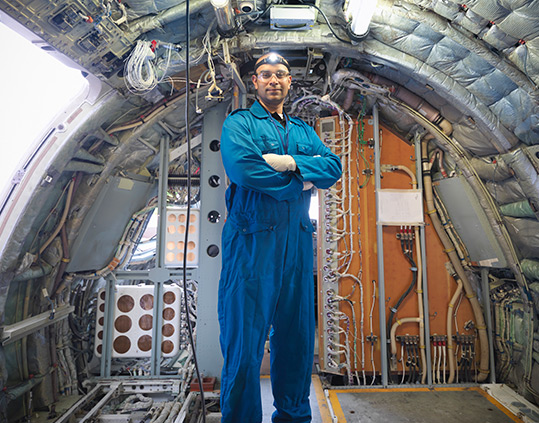
Aerospace, Defense, and Government Case Studies
Learn how researchers and developers used NI hardware and software for design, test, and deployment of aerospace, defense, and government solutions.
Research, Design, and Prototyping

Learn how scientists, researchers, and design engineers use NI hardware and software to conduct cutting-edge research and prototyping.
Digilogic Systems Pvt. developed the Modular Rugged Chassis for PXI Express commercial off-the-shelf (COTS) systems for deployments in military applications.
Elettronica GmbH created a cost-effective, compact device to continuously record and evaluate electronic signal intelligence (ELINT) signals.
Researchers built a flip coil measurement system to create control programs that match the test contents for performing DC integral magnetic field measurements.
Warsaw University of Technology used NI commercial off-the-shelf (COTS) products to quickly design, deploy, and test active and passive radars.
Researchers built a system for analyzing and displaying radar data from high-resolution millimeter-wave radar front ends to detect small debris on airport runways.
University of Surrey designed a system to reliably control and manage all components while researching a method for quantum computing at the HFML and FELIX facilities.
SkySafe delivered a drone defense solution faster and at a lower cost with NI software defined radio (SDR) products.
EPFLoop built a prototype transport vehicle (pod) control system to demonstrate the hyperloop concept for a SpaceX global competition.
Researchers improved the beam diagnostic system for the ISIS 50 Hz synchrotron to monitor and control the accelerator with increased quantity, accuracy, and speed.
Tokamak Energy created a system with a centralized control room, which supports multiuser interfaces, to demonstrate fusion energy temperatures of 1,000,000 °C.
The EPFLoop team combined the benefits of the CompactRIO platform and LabVIEW Real-Time to create a time-deterministic, fault-tolerant control system for a prototype transport vehicle.
Validation

Explore how validation and verification teams use the NI platform to perform hardware-in-the-loop testing, embedded software validation, and design verification early in the product development process.
NI and EN4, an NI partner, collaborated to help Lilium develop a modular and extendable testing environment for their eVTOL aircraft.
Rocket Factory Augsburg partnered with NI to test subsystems across a launch vehicle platform including the rocket engine, fuselage, and avionics.
Researchers facilitated the functionality tests of the SSR transponder in accordance with RTCA/ICAO required documents to develop the XPDR Test System.
G Systems created a high-channel-count system to acquire analog, digital, video, and additional data for the Lockheed Martin F-35 VSIF.
Airbus Military created a test system for the electrical system of an unmanned aerial vehicle (UAV) with power generation and power distribution.
DSPL developed a portable and scalable Radar Target Echo Simulator in six months to perform realistic field signals for the evaluation of radars in a lab.
Researchers built a hardware-in-the-loop (HIL) test bench through a holistic validation strategy for the embedded systems in an armored multipurpose vehicle (AMPV).
Researchers developed a system to improve the integration and development efficiency of satellite test systems and to shorten the satellite development cycle.
Loccioni and Avio Aero created a distributed real-time architecture, interconnected using deterministic bus protocol for aircraft engine validation and more.
Raytheon Missile Systems reduced test cycle time by 95 percent for cross-departmental test information management of exoatmospheric ballistic missile testing.
NASA developed non-proprietary data acquisition system (DAS) software to support government and commercial rocket engine testing on multiple test facilities.
Northrop Grumman Space Technology created an inexpensive method for quickly locating, organizing, and analyzing binary telemetry data files.
STFC RAL Space developed and tested cameras to retrieve and reconstruct image data as well as video footage of Earth from space in real time.
SAAB Aeronautics used the Switch Load and Signal Conditioning (SLSC) system to replace a custom system for interfacing to line-replaceable units in simulators.
Moog India Technology Center developed a fast, flexible, reliable, maintainable, and upgradable software test platform (STP) to test flight actuation systems.
Leveraging the PXI platform, OSL built a universal test system for satellite payload power supplies. It reduces test time by 10X and supports board- and package-level testing.
Using LabVIEW, CompactDAQ hardware, and a set of high-accuracy sensors and transducers, Aerostar complemented their test bench’s original data acquisition system with the desired parameters with no interruption in delivering engines to customers.
Production Test

Discover how manufacturing and operations professionals are able to increase quality, yield, and efficiency by automating production test systems with the NI platform.
The DAIMsphere solution, based on SystemLink, helps break down fragmented data silos and establishes a single source of truth across the board, allowing for profound test data management.
M3 Systems embedded NI technology with the STELLA-NGC Global Navigation Satellite System (GNSS) simulator to manage multiconstellations and multifrequency approaches.
Airbus added intelligence to tools and shopfloor systems to simplify the production process and improved production efficiency by managing operator tasks.
ISRO created a modular software-defined compact tester for flight package evaluation in different conditions, portable for different test facilities.
Captronic Systems Pvt Ltd. created an automated and scalable solution to test the entire range of radar function for secondary surveillance radar (SSR).
Maintenance and Monitoring

Learn how the NI platform can be used to monitor critical assets and maintain and sustain long lifecycle programs.
Lockheed Martin STS standardized test system development for avionics test systems that yielded cost-saving benefits for LM, suppliers, and the U.S. government.
CACI developed an automated test system using commercially available technology to replace the legacy test systems in use by the Department of Defense (DoD).
Researchers created a remote ground control system to control and monitor Stratos II+ rocket procedures during the engine test campaign and the launch campaign.
NSPA developed and tested a replacement transmitter control unit (TCU) to manage the operation of the modulator’s radar transmitter while saving time and cost.
The Royal Dutch Navy used commercial off-the-shelf components to replace an outdated and obsolete proprietary naval computer test system used on navy ships.
Researchers developed a signal processing embedded system for real-time detection and quantification of fugitive natural gas emissions using lidar.